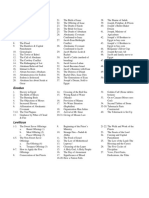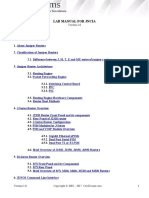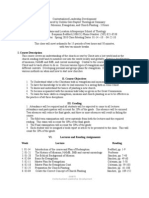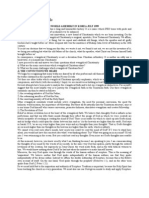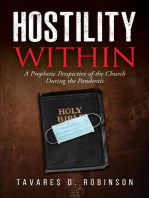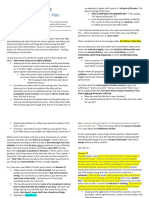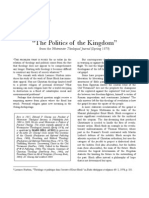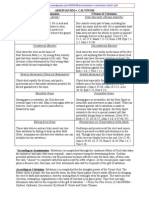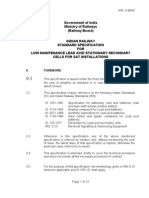Mark 11 Bible Study (Tim Keller) - The Final Temple
Mark 11 Bible Study (Tim Keller) - The Final Temple
Uploaded by
Sisca HadinataCopyright
Available Formats
Share this document
Did you find this document useful?
Is this content inappropriate?
Report this DocumentCopyright:
Available Formats
Mark 11 Bible Study (Tim Keller) - The Final Temple
Mark 11 Bible Study (Tim Keller) - The Final Temple
Uploaded by
Sisca HadinataCopyright:
Available Formats
Mark 11:1-12:17
The final temple
Mark
Biblical-theological background for Mark 11-15
OPTIONAL STUDY
If we are to appreciate the meaning of the triumphal entry and the cleansing of
the temple (in Mark 11), and indeed, the whole of Mark 11-15 (which takes place
in and around the temple) we need to have a deep grasp of the rich Old
Testament background.
1. In the beginning, God gave us a “sanctuary,” a place where we could live
in the presence of God and meet him face to face. That sanctuary was the
Garden of Eden (Genesis 2:8-9; Genesis 3:8-9). It was a place of total
fulfillment and fellowship with God. It was the place of shalom, perfect
peace and harmony.
2. But because of sin, we were banished from the sanctuary of God’s
presence — a flaming sword was put at the entrance of the Garden
(Genesis 3:24). This was a representation that the penalty for sin is death.
The way back into the presence of God is blocked by justice. There is no
way back into the presence of God without going under the sword.
3. In the wilderness, God created a moveable sanctuary — the tabernacle
where people could draw near to meet him (Exodus 25:22). The
actual throne room of the sanctuary was the Holy of Holies, separated by a
thick curtain/barrier, which had pictures of the Garden on it, motifs of
cherubim and palm trees (Exodus 26). But only the high priest could go into
the Holy of Holies, and then only once a year. He had to go “under the
sword” with a blood sacrifice, symbolically atoning for sin, paying the
penalty in order to go in to God’s presence. At the conclusion of the
tabernacle service, God blessed the people with his shalom or peace
(Numbers 6:24-27). The shekinah glory of God’s holiness dwells behind the
veil in the sanctuary and no sinner can enter there.
4. Though God allows Solomon to build a permanent physical sanctuary
(I Kings 8:41-43), yet he alludes to a Son of David building a truly
permanent “house” for God and us (2 Samuel 5:6-10; 7:1-16). Since
Solomon is not this true Son, his temple is destroyed (I Kings 11:11-13;
2 Kings 25:8-11). During the exile, Ezekiel prophesies a new temple and a
new David to build it (Ezekiel 37:24-28; 40-43). It will be much grander than
Solomon’s temple. The Lord’s glory will fill it (Ezekiel 48:35), and it will
become so large that all the nations of the earth will come to it and into it
(Ezekiel 37:28).
5. The temple built after the exiles returned to Israel from Babylon did not
fulfill this grand vision of the prophets. When the new foundation was laid,
the older people wept because it was far less splendid than Solomon’s, not
more (Ezra 3:12). It was this post-exilic temple that existed in Jesus’ day.
140
Copyright © Timothy J. Keller, and Redeemer Presbyterian Church 2005
THE FINAL TEMPLE
So this temple was not the one that was prophesied (Haggai 2:1-8). That one
would only be built when the Messiah, the new “David” came.
6. Zechariah 9-14 is critical for understanding Mark 11. Zechariah 9:9-12 tells
of the Messiah, the king coming back “gentle and riding on a colt, the
foal of a donkey.” The prophecy ends in a stunning way. “On that day
HOLY TO THE LORD will be inscribed on the bells of the horses, and the
cooking pots in the Lord’s house will be like the sacred bowls in front of
the altar. Every pot in Jerusalem and Judah will be holy to the Lord
Almighty… And on that day there will no longer be a Canaanite in the
house of the Lord Almighty” (Zechariah 14:20-21). Here we are told that
the returning king will turn the entire city — even the entire world — into
a giant holy of holies. It is a breath-taking and overwhelming vision. Even
cooking pots will be as holy as those before God’s throne. The Holy of
Holies will extend to include the whole world, so that even the
Canaanites will be holy and living in the house of the Lord (Zechariah
14:21). This means that the Messiah will not simply build a building, but
will mediate the very presence of God back to earth. He will BE the door
to God, the final temple.
7. Mark 11 is essentially showing how Jesus fulfills this prophecy of
Zechariah, and thus all the prophecies of the Old Testament that linked
the Messiah to the temple. John is more explicit than Mark. He says,
“the word became flesh and tabernacled among us, and we beheld his
glory” (1:14). He tells us how, after Jesus cleansed the temple, he refers
to his body as the temple (2:19-21). John records Jesus saying “I am the
Way, the Truth, the Life. No one comes to the Father but by me” (John
14:6). Jesus is the final temple. In Mark 15:38, we are told how this could
be —the curtain of the temple was torn in two from top to bottom. Jesus
went under the sword (Genesis 3:24). He took the sword into himself. He
was the High Priest opening the way into the Holy of Holies, but he made
himself the sacrifice. He paid the price to open the door.
8. In Mark and the other gospels, Jesus is depicted as “the final temple”.
He thus brings us a salvation of unfathomable wisdom and richness. The
ripping of the veil signifies the “outbreaking” of God’s royal, healing
presence into the world — this is the coming of the kingdom. What does
it all mean?
a. It means that Christ is not primarily a teacher, but a Savior. This is why
Mark concentrates not so much on his moral advice, but on who he is
and what he did. He comes to open the way into God for us.
b. It means that being a Christian is not primarily being a nice person
who subscribes to certain beliefs and codes. It is a radical
141 Optional study | The final temple
Copyright © Timothy J. Keller, and Redeemer Presbyterian Church 2005
THE FINAL TEMPLE
regeneration of the heart and reorientation of the life. We are
regenerated when we believe (John 3:3), because now the same raw
presence that once shook mountains, terrified people, killed living
things on contact now can live in us. For we who believe in Jesus are
now temples in which the Holy Spirit of God dwells
(I Corinthians 6:19; 2 Corinthians 6:16).
c. It means that being a Christian gives us access to the presence of
God through prayer now, and access to the bosom of God in the
future. Moses’ unrealizable yearning to see the light of God’s glory
and face (Exodus 33:18) is now our privilege (John 1:14;
2 Corinthians 4:6).
d. It means that being a Christian makes us partners and participants
with Christ in his work of spreading the healing and energizing
kingdom-power through the world. Because Jesus is the temple, we
too are the final temple, “living stones” in it (I Peter 2:4-10). Because
Jesus is the High Priest, we are “priests” who can both draw near to
God (Hebrews 4:14-16) and bring others to God (Hebrews 13).
Because Jesus is a gate to heaven (John 1:51; John 14:6) we are
linked to heaven (Colossians 2:20; Philippians 3:20). Because Jesus is
an anointed one (Luke 4:18), as was the temple, so we are anointed (I
John 2:20). All the lines and themes of the temple converge on Jesus
— he is the Sacrifice, the Priest, the Altar, the Light, the Bread, the
blood of purification. For all the promises of God become “Yes” in
Jesus (2 Corinthinans 1:20).
142
Copyright © Timothy J. Keller, and Redeemer Presbyterian Church 2005
You might also like
- Acts Bible StudyDocument162 pagesActs Bible StudyLuke Skeen100% (6)
- Bible Chapter Titles: GenesisDocument11 pagesBible Chapter Titles: Genesis14569874100% (1)
- Ephesians Study Guide 01Document1 pageEphesians Study Guide 01Rubén Ariel MorenoNo ratings yet
- 2 Kings 4 - Beth Moore Girl A To ZDocument7 pages2 Kings 4 - Beth Moore Girl A To ZJoaniBaileyRossNo ratings yet
- Saints of Zion BookletDocument30 pagesSaints of Zion BookletJoshua Alexander100% (1)
- Sermon Notes: "The Lord of The Harvest" (Luke 10:1-16)Document3 pagesSermon Notes: "The Lord of The Harvest" (Luke 10:1-16)NewCityChurchCalgaryNo ratings yet
- Part 11 - Worship - God TransformsDocument10 pagesPart 11 - Worship - God TransformsBradley Sheldon LaneNo ratings yet
- Rut Rot or RevivalDocument3 pagesRut Rot or RevivalTerry DehartNo ratings yet
- When Calvinism Goes Bad Part 1 Tim ConwayDocument10 pagesWhen Calvinism Goes Bad Part 1 Tim Conwayem rqdNo ratings yet
- Normal Distribution Slides Questions Solutions: Example 1Document3 pagesNormal Distribution Slides Questions Solutions: Example 1Dipak Kumar PatelNo ratings yet
- The Chair SuspensionDocument8 pagesThe Chair SuspensionChris BrookesNo ratings yet
- Juniper Lab GuideDocument186 pagesJuniper Lab GuidevsaraNo ratings yet
- A Theology of CitiesDocument5 pagesA Theology of CitiesJohnny TelesNo ratings yet
- Keller Gospel TheologyDocument18 pagesKeller Gospel TheologycoburNo ratings yet
- The Gospel and The PoorDocument16 pagesThe Gospel and The PoorBruce Lawrence MadeirosNo ratings yet
- IllustrationsDocument33 pagesIllustrationsWeyms SanchezNo ratings yet
- Atonement Grammars, The Cross by Tim KellerDocument3 pagesAtonement Grammars, The Cross by Tim KellerNick HillNo ratings yet
- H E A Atur Re of F ON Nfli CT: Why S Study P Peacem Making?Document6 pagesH E A Atur Re of F ON Nfli CT: Why S Study P Peacem Making?Aldair Martins Figueiredo JuniorNo ratings yet
- Alpha and OmegaDocument10 pagesAlpha and OmegaatjonesNo ratings yet
- 1 Peter Student's GuideDocument25 pages1 Peter Student's GuideAnonymous J4Yf8FNo ratings yet
- The Blueprint For Biblical EducationDocument8 pagesThe Blueprint For Biblical EducationrtdiazNo ratings yet
- The Shepherd's HeartDocument4 pagesThe Shepherd's Heartplay6420% (1)
- Sermon - What If God Was One of Us? (Matthew 1:18-25)Document3 pagesSermon - What If God Was One of Us? (Matthew 1:18-25)NewCityChurchCalgaryNo ratings yet
- CLD Syllaby CLI 1351 Missions, Evangelism, and Church Planting (Spanish) Spring 2010Document2 pagesCLD Syllaby CLI 1351 Missions, Evangelism, and Church Planting (Spanish) Spring 2010rmurillo4No ratings yet
- Grieving, Hope & Solace, Sample PagesDocument8 pagesGrieving, Hope & Solace, Sample PagesCruciform PressNo ratings yet
- D Christology and SoteriologyDocument33 pagesD Christology and SoteriologyBond PaperNo ratings yet
- Starting A YM From ScratchDocument16 pagesStarting A YM From ScratchjuunkmayilNo ratings yet
- Lectionary Readings by Book of The BibleDocument21 pagesLectionary Readings by Book of The Bibletimeless wunNo ratings yet
- BE BookletDocument49 pagesBE Bookletjhansen007100% (1)
- Jesus Christ and The Everlasting Gospel - AssessmentDocument14 pagesJesus Christ and The Everlasting Gospel - AssessmentJohnElliesPerezNo ratings yet
- Evangelical Essentials StottDocument6 pagesEvangelical Essentials Stottapi-3748147No ratings yet
- 2nd Sunday of AdventDocument5 pages2nd Sunday of AdventDarwin SolanoyNo ratings yet
- What Is The Gospel of Jesus (Final)Document5 pagesWhat Is The Gospel of Jesus (Final)NigelNo ratings yet
- Kaiser - The Indwelling Presence of The Holy Spirit in OTDocument8 pagesKaiser - The Indwelling Presence of The Holy Spirit in OTcatalinvarga1987No ratings yet
- Hostility Within: A Prophetic Perspective of the Church During the PandemicFrom EverandHostility Within: A Prophetic Perspective of the Church During the PandemicNo ratings yet
- Romans - Series 1Document201 pagesRomans - Series 1ebookreaderNo ratings yet
- Talk 3 REPENTANCE AND FAITHDocument5 pagesTalk 3 REPENTANCE AND FAITHVoltaire VillanuevaNo ratings yet
- Prophecies of Revelation For Teens (Seth J. Pierce)Document261 pagesProphecies of Revelation For Teens (Seth J. Pierce)Andri Setyo PujiNo ratings yet
- Ministry 2015, MarchDocument32 pagesMinistry 2015, MarchnicolasmarieNo ratings yet
- God's Son "Forsaken," His Sacrifice "Finished!": Christ’s Atoning Sacrifice — from His Own PerspectiveFrom EverandGod's Son "Forsaken," His Sacrifice "Finished!": Christ’s Atoning Sacrifice — from His Own PerspectiveRating: 5 out of 5 stars5/5 (1)
- GALATIANS 1 - Timothy KellerDocument12 pagesGALATIANS 1 - Timothy KellerNIKKOLASINo ratings yet
- What Is The Gospel?Document22 pagesWhat Is The Gospel?AndreNo ratings yet
- Understanding The Apostles CreedDocument11 pagesUnderstanding The Apostles Creeddojie gumataNo ratings yet
- ResurrectionDocument4 pagesResurrectionMichael Jomar IsonNo ratings yet
- It's All Part of The Plan: Genesis 37-50Document9 pagesIt's All Part of The Plan: Genesis 37-50Trisha Dela CruzNo ratings yet
- Second Coming TheoriesDocument2 pagesSecond Coming TheoriesKogiilahNo ratings yet
- God's Big Story Blank BookletDocument8 pagesGod's Big Story Blank BookletKristi StephensNo ratings yet
- 02 How To Experience New LifeDocument44 pages02 How To Experience New LiferobinrubinaNo ratings yet
- Exegesis of Joel 2 28 32Document11 pagesExegesis of Joel 2 28 32Stefan AsavoaeNo ratings yet
- BiblicalManWorksheet - DriscollDocument3 pagesBiblicalManWorksheet - DriscollSam HarrellNo ratings yet
- Clowney - Politics of The KingdomDocument11 pagesClowney - Politics of The Kingdomslin_46No ratings yet
- Defence of Infant Baptism (Historio-Theological Approach)Document33 pagesDefence of Infant Baptism (Historio-Theological Approach)Godswill M. O. Ufere100% (1)
- Microsoft Word - The Five 'R'sDocument5 pagesMicrosoft Word - The Five 'R'sPaulNo ratings yet
- Post Everythings by Tim KellerDocument3 pagesPost Everythings by Tim Kellersmerickson100% (5)
- 1 Genesis Pt. 1 Study GuideDocument8 pages1 Genesis Pt. 1 Study GuideErant LuciNo ratings yet
- Walvoord John The Holy Spirit and Spiritual GiftsDocument15 pagesWalvoord John The Holy Spirit and Spiritual Giftsapi-242911311No ratings yet
- Ism V Calvinism ChartDocument1 pageIsm V Calvinism ChartIsoQuanticNo ratings yet
- 1 Corinthians 5Document9 pages1 Corinthians 5Obra MaestroNo ratings yet
- 0409 001 - Tim Keller PDFDocument46 pages0409 001 - Tim Keller PDFMiguel Davilla100% (1)
- PDF Beyond Accountability 2021 UPDATE TaglnbDocument60 pagesPDF Beyond Accountability 2021 UPDATE TaglnbSergio QuiñonesNo ratings yet
- Bi 401 Study GuideDocument56 pagesBi 401 Study GuideAsanc Asana100% (3)
- Agnes Martin - Lugand - Imi Pare Rau Sunt AsteptataDocument24 pagesAgnes Martin - Lugand - Imi Pare Rau Sunt AsteptataElena Mitrica25% (4)
- Csec Physics 2018Document24 pagesCsec Physics 2018Ganga Singh70% (10)
- Chapter 3 UpdatedDocument45 pagesChapter 3 Updatedfilibertpatrick_tad-awanNo ratings yet
- Dielectric Constant TableDocument51 pagesDielectric Constant TableJoaquin Luna100% (1)
- SetsDocument69 pagesSetsJeffrey CabarrubiasNo ratings yet
- Economic and Political Weekly Economic and Political WeeklyDocument6 pagesEconomic and Political Weekly Economic and Political WeeklyJentle VargheseNo ratings yet
- HP Auto Port Aggregation (APA) Release HP UX 11.33Document8 pagesHP Auto Port Aggregation (APA) Release HP UX 11.33icanariNo ratings yet
- Angkur BetonDocument36 pagesAngkur BetonmhadihsNo ratings yet
- Lymph Angio Lei o Myoma To SisDocument9 pagesLymph Angio Lei o Myoma To SisEULA MARIE JOVERNo ratings yet
- Following Jesus: Being A Peacemaker: Peacemakers Are Not Passive They Are Persuasive in The Savior's WayDocument5 pagesFollowing Jesus: Being A Peacemaker: Peacemakers Are Not Passive They Are Persuasive in The Savior's WayAlexander Bryan RojasNo ratings yet
- IRS S 88-93 - For Low Maintenance Lead Acid Stationary Sec CeDocument10 pagesIRS S 88-93 - For Low Maintenance Lead Acid Stationary Sec CeVikas Srivastav100% (1)
- Distinctive Features of The QuranDocument11 pagesDistinctive Features of The QuranzhihuiNo ratings yet
- CAPE Associate Degree HandbookDocument24 pagesCAPE Associate Degree Handbookkyle100% (1)
- 1st Summative Test in English 5Document4 pages1st Summative Test in English 5Wize DeeNo ratings yet
- Reflection Form For Graduate ChallengeDocument2 pagesReflection Form For Graduate ChallengeAfsheen Danish NaqviNo ratings yet
- FABMQ1 Mod1 R.Olegario-pages-deletedDocument21 pagesFABMQ1 Mod1 R.Olegario-pages-deletedCjNo ratings yet
- E6Document29 pagesE6Gaurav GargNo ratings yet
- Load Balancing Interview QuestionsDocument18 pagesLoad Balancing Interview QuestionsPhillipNo ratings yet
- Trabalho para ExameDocument4 pagesTrabalho para ExameJanahyna FlausinoNo ratings yet
- Worksheet Reversible ReactionDocument3 pagesWorksheet Reversible ReactionG M Ali KawsarNo ratings yet
- Failed Reheater Showing Thin Lipped RuptureDocument4 pagesFailed Reheater Showing Thin Lipped Rupturefernandosimic96No ratings yet
- Antiepileptic Drugs 2019 Elearning PDFDocument39 pagesAntiepileptic Drugs 2019 Elearning PDFMalvika BabuNo ratings yet
- Biology: Unit: KBI0/4BI0 Paper: 2BDocument16 pagesBiology: Unit: KBI0/4BI0 Paper: 2BMohamedNo ratings yet
- Grammar-Voc - Reading Örnek StsDocument9 pagesGrammar-Voc - Reading Örnek StsSantiago RamirezNo ratings yet
- Emergency Relief Organisations - CitywideDocument17 pagesEmergency Relief Organisations - CitywideRobert DennysNo ratings yet
- Flat Earth MapDocument3 pagesFlat Earth MapKRIS -LIKENo ratings yet

